考研英语复习——答题卡注意事项
- 格式:docx
- 大小:13.94 KB
- 文档页数:2
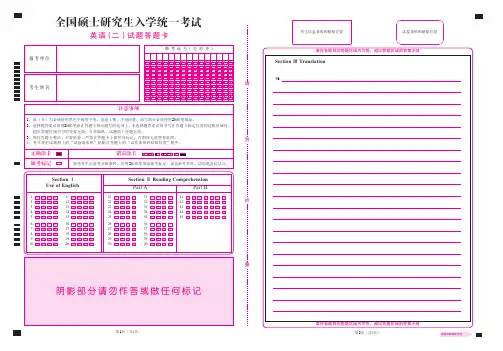
全国硕士研究生入学统一考试英语(二)试题答题卡报考单位考生姓名A A A A A A A A A A A A A A A A A A A A A A A A A AA A A A A A A A A A A AA A A A A A AB B B B B E BB BB B B B B B E B B B B B B B B B E B B B B B B B B B E B B B B B B B B B E B B B BC C C C C F C C C C C C C C C F C C C C C C C C C F C C C C C C C C C F C C C C C C C C C F C C C CD D D D D G D D D DDD D DD GDD D DDD D DD GDD D DD D D D D GD D D DD D D D D G D D D D111213141616263631323334381828382122232427172737414243444919293951525354510203040Section ⅠSection Ⅱ Reading ComprehensionUse of English Part A Part B第1页(共4页)Section Ⅲ Translation 46.考生信息条形码粘贴位置试卷条形码粘贴位置请在各题目的答题区域内作答,超出答题区域的答案无效请在各题目的答题区域内作答,超出答题区域的答案无效第2页(共4页)Section Ⅳ Writing Part ASection Ⅳ WritingPart B 47.48.请在各题目的答题区域内作答,超出答题区域的答案无效请在各题目的答题区域内作答,超出答题区域的答案无效请在各题目的答题区域内作答,超出答题区域的答案无效请在各题目的答题区域内作答,超出答题区域的答案无效第3页(共4页)第4页(共4页)考生姓名:____________________98。
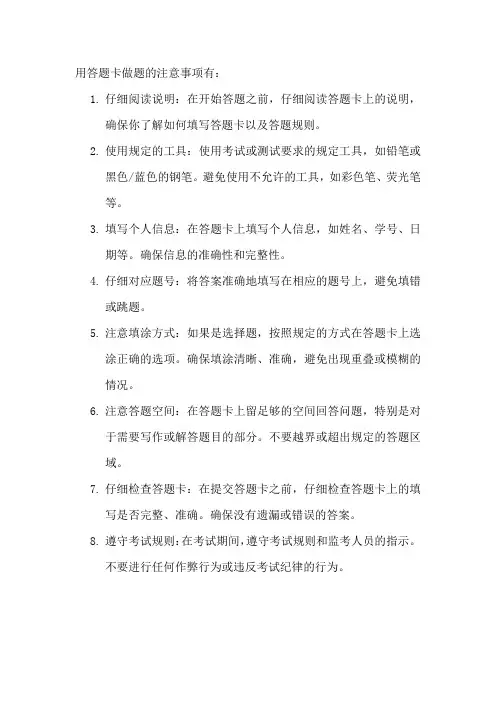
用答题卡做题的注意事项有:
1.仔细阅读说明:在开始答题之前,仔细阅读答题卡上的说明,
确保你了解如何填写答题卡以及答题规则。
2.使用规定的工具:使用考试或测试要求的规定工具,如铅笔或
黑色/蓝色的钢笔。
避免使用不允许的工具,如彩色笔、荧光笔等。
3.填写个人信息:在答题卡上填写个人信息,如姓名、学号、日
期等。
确保信息的准确性和完整性。
4.仔细对应题号:将答案准确地填写在相应的题号上,避免填错
或跳题。
5.注意填涂方式:如果是选择题,按照规定的方式在答题卡上选
涂正确的选项。
确保填涂清晰、准确,避免出现重叠或模糊的情况。
6.注意答题空间:在答题卡上留足够的空间回答问题,特别是对
于需要写作或解答题目的部分。
不要越界或超出规定的答题区域。
7.仔细检查答题卡:在提交答题卡之前,仔细检查答题卡上的填
写是否完整、准确。
确保没有遗漏或错误的答案。
8.遵守考试规则:在考试期间,遵守考试规则和监考人员的指示。
不要进行任何作弊行为或违反考试纪律的行为。
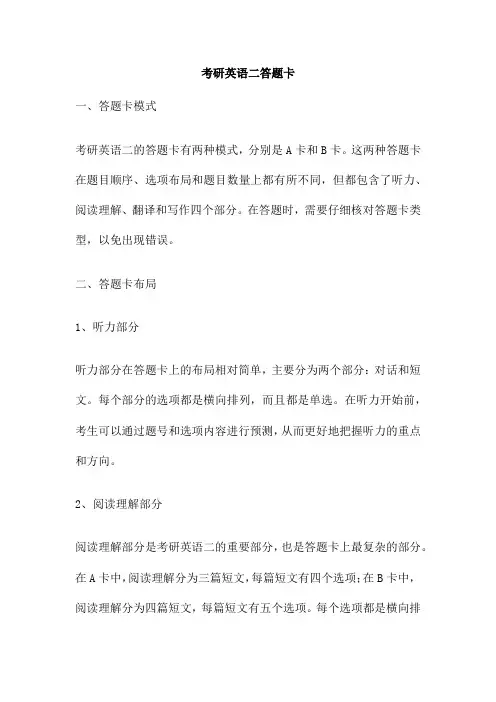
考研英语二答题卡一、答题卡模式考研英语二的答题卡有两种模式,分别是A卡和B卡。
这两种答题卡在题目顺序、选项布局和题目数量上都有所不同,但都包含了听力、阅读理解、翻译和写作四个部分。
在答题时,需要仔细核对答题卡类型,以免出现错误。
二、答题卡布局1、听力部分听力部分在答题卡上的布局相对简单,主要分为两个部分:对话和短文。
每个部分的选项都是横向排列,而且都是单选。
在听力开始前,考生可以通过题号和选项内容进行预测,从而更好地把握听力的重点和方向。
2、阅读理解部分阅读理解部分是考研英语二的重要部分,也是答题卡上最复杂的部分。
在A卡中,阅读理解分为三篇短文,每篇短文有四个选项;在B卡中,阅读理解分为四篇短文,每篇短文有五个选项。
每个选项都是横向排列,而且都是单选。
在阅读理解部分,考生需要快速阅读文章并理解文章主旨和细节,同时注意选项中的陷阱和干扰项。
3、翻译部分翻译部分在答题卡上的布局相对简单,主要分为两个部分:英译中和中译英。
每个部分的句子都是纵向排列,而且都是单选。
在翻译部分,考生需要准确理解原文的意思,并用流畅的语言将其表达出来。
同时需要注意时态、语态和语法等细节问题。
4、写作部分写作部分是考研英语二的另一重要部分,也是答题卡上最容易失分的部分。
在A卡中,写作分为两道题目,每道题目都有相应的要求和提示;在B卡中,写作只有一道题目,没有提示和要求。
每个题目的回答都需要考生自己组织语言并表达出来,而且需要注意语法、拼写和标点等细节问题。
三、答题技巧1、快速浏览题目和选项在开始答题之前,考生可以先快速浏览一下题目和选项,了解每个部分的主题和要求,以便更好地把握答题的方向和重点。
2、注意时间分配在答题过程中,考生需要注意时间分配,合理安排每个部分的时间。
如果某个部分比较难或者花费的时间比较多,可以适当调整时间分配。
3、注意细节问题在答题过程中,考生需要注意细节问题,如语法、拼写、标点等。
这些细节问题可能会影响整个答案的质量和得分。
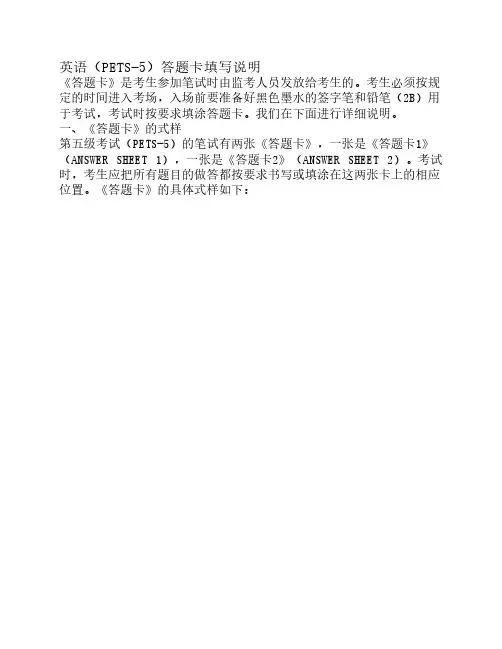
英语(PETS-5)答题卡填写说明《答题卡》是考生参加笔试时由监考人员发放给考生的。
考生必须按规定的时间进入考场,入场前要准备好黑色墨水的签字笔和铅笔(2B)用于考试,考试时按要求填涂答题卡。
我们在下面进行详细说明。
一、《答题卡》的式样第五级考试(PETS-5)的笔试有两张《答题卡》,一张是《答题卡1》(ANSWER SHEET 1),一张是《答题卡2》(ANSWER SHEET 2)。
考试时,考生应把所有题目的做答都按要求书写或填涂在这两张卡上的相应位置。
《答题卡》的具体式样如下:二、《答题卡》的填涂说明㈠《答题卡1》(ANSWER SHEET 1)的填涂说明⒈《答题卡1》姓名和准考证号栏考生在姓名栏的横线上用黑色墨水的签字笔以楷书的字体工整地填写自己的汉字姓名。
如,某考生李丽,填写式样应为姓名:李丽考号栏的填涂方法及注意事项参见《口试卡》中的准考证号的填涂方法。
⒉《答题卡1》示意图上的听力理解部分(Section I: Listening Comprehension)的录音材料由放音设备在考试时播放。
该部分由Part A、Part B、Part C三节构成。
Part A共10个题,属判断正误题。
考生将听到一段对话或独白。
试卷上有10个陈述句,要求考生根据所听到的这段对话或独白,判断10个陈述句的正误,并在答题卡上每个题号后面把代表正(T)或误(F)所在的字母框用铅笔(2B)涂黑。
录音材料只播放一遍,10个陈述句在试卷上印出,录音中不播放;听该部分的对话或独白前,考生有1分钟的时间阅读10个陈述句。
Part B共10个题,属四选一题型。
考生将听到3段对话或独白。
每段对话或独白后面都有几个题目,每个题目后面有4个选项供考生选择答题。
要求考生根据所听到的对话或独白,从每题所给的4个选择项中选出最佳选项。
录音材料只播放一遍,问题在试卷上印出,录音中不播放;听该部分的每段对话或独白前,考生都有一定的时间阅读问题。
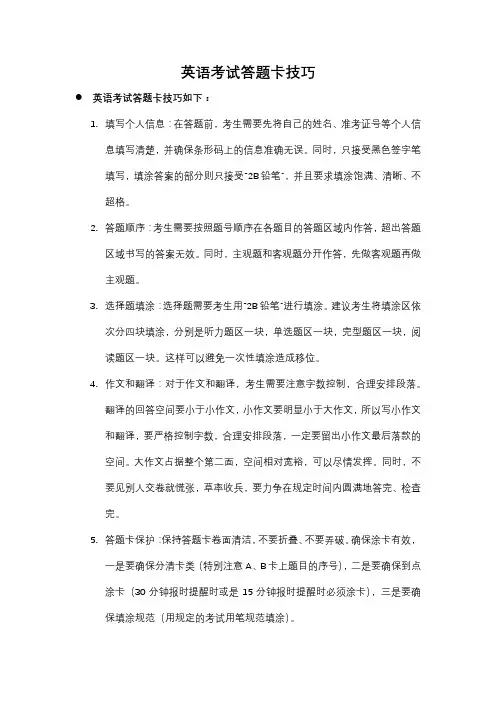
英语考试答题卡技巧
英语考试答题卡技巧如下:
1.填写个人信息:在答题前,考生需要先将自己的姓名、准考证号等个人信
息填写清楚,并确保条形码上的信息准确无误。
同时,只接受黑色签字笔填写,填涂答案的部分则只接受“2B铅笔”,并且要求填涂饱满、清晰、不超格。
2.答题顺序:考生需要按照题号顺序在各题目的答题区域内作答,超出答题
区域书写的答案无效。
同时,主观题和客观题分开作答,先做客观题再做主观题。
3.选择题填涂:选择题需要考生用“2B铅笔”进行填涂。
建议考生将填涂区依
次分四块填涂,分别是听力题区一块,单选题区一块,完型题区一块,阅读题区一块。
这样可以避免一次性填涂造成移位。
4.作文和翻译:对于作文和翻译,考生需要注意字数控制,合理安排段落。
翻译的回答空间要小于小作文,小作文要明显小于大作文,所以写小作文和翻译,要严格控制字数,合理安排段落,一定要留出小作文最后落款的空间。
大作文占据整个第二面,空间相对宽裕,可以尽情发挥。
同时,不要见别人交卷就慌张,草率收兵,要力争在规定时间内圆满地答完、检查完。
5.答题卡保护:保持答题卡卷面清洁,不要折叠、不要弄破。
确保涂卡有效,
一是要确保分清卡类(特别注意A、B卡上题目的序号),二是要确保到点涂卡(30分钟报时提醒时或是15分钟报时提醒时必须涂卡),三是要确保填涂规范(用规定的考试用笔规范填涂)。
以上技巧仅供参考,不同考试要求不同,建议考生在备考期间多做模拟试题,熟悉答题规范和技巧。
同时,考试时稳定心态,正常发挥,争取取得好成绩。
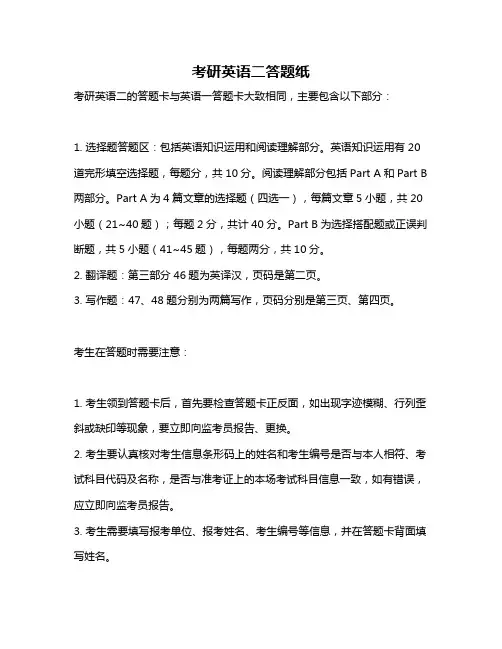
考研英语二答题纸
考研英语二的答题卡与英语一答题卡大致相同,主要包含以下部分:
1. 选择题答题区:包括英语知识运用和阅读理解部分。
英语知识运用有20道完形填空选择题,每题分,共10分。
阅读理解部分包括Part A和Part B 两部分。
Part A为4篇文章的选择题(四选一),每篇文章5小题,共20小题(21~40题);每题2分,共计40分。
Part B为选择搭配题或正误判断题,共5小题(41~45题),每题两分,共10分。
2. 翻译题:第三部分46题为英译汉,页码是第二页。
3. 写作题:47、48题分别为两篇写作,页码分别是第三页、第四页。
考生在答题时需要注意:
1. 考生领到答题卡后,首先要检查答题卡正反面,如出现字迹模糊、行列歪斜或缺印等现象,要立即向监考员报告、更换。
2. 考生要认真核对考生信息条形码上的姓名和考生编号是否与本人相符、考试科目代码及名称,是否与准考证上的本场考试科目信息一致,如有错误,应立即向监考员报告。
3. 考生需要填写报考单位、报考姓名、考生编号等信息,并在答题卡背面填写姓名。
4. 考生在核对无误后将考生信息条形码和试卷信息条形码贴在答题卡的对应标志区域。
以上信息仅供参考,建议查阅考研英语二的官方网站或者咨询考试中心获取更多信息。
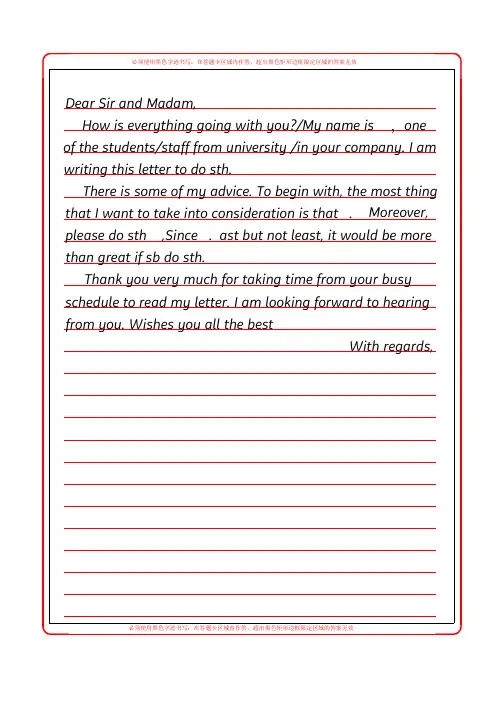
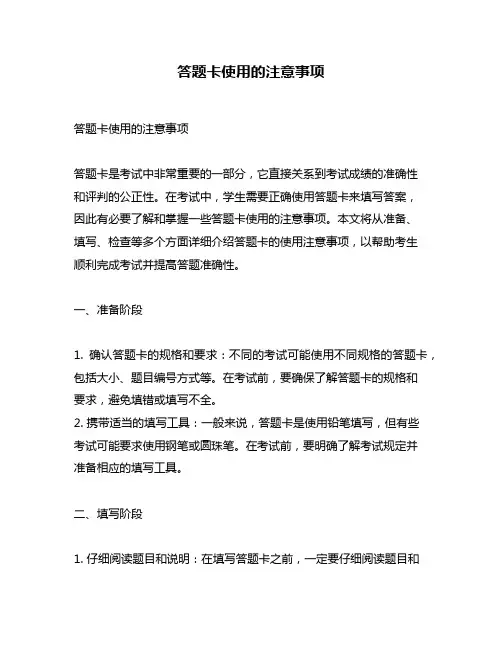
答题卡使用的注意事项答题卡使用的注意事项答题卡是考试中非常重要的一部分,它直接关系到考试成绩的准确性和评判的公正性。
在考试中,学生需要正确使用答题卡来填写答案,因此有必要了解和掌握一些答题卡使用的注意事项。
本文将从准备、填写、检查等多个方面详细介绍答题卡的使用注意事项,以帮助考生顺利完成考试并提高答题准确性。
一、准备阶段1. 确认答题卡的规格和要求:不同的考试可能使用不同规格的答题卡,包括大小、题目编号方式等。
在考试前,要确保了解答题卡的规格和要求,避免填错或填写不全。
2. 携带适当的填写工具:一般来说,答题卡是使用铅笔填写,但有些考试可能要求使用钢笔或圆珠笔。
在考试前,要明确了解考试规定并准备相应的填写工具。
二、填写阶段1. 仔细阅读题目和说明:在填写答题卡之前,一定要仔细阅读题目和说明,确保正确理解题目要求和填写方式。
2. 注意填写位置:答题卡上通常会有明确的题号和填写位置,要确保将答案填写到正确的位置上,避免填写错误或跳题。
3. 清晰填写:填写答题卡时要注意写字清晰,避免模糊不清或误认为其他字符。
4. 注意使用符号:一些题目可能需要填写符号,如√、x等,要确保使用正确符号并填写规范。
5. 确认答案:填写答题卡后,要仔细确认所填答案的正确性,避免填错或漏填。
6. 使用答题卡的提示功能:一些答题卡可能设有提示功能,如提供选项的关键词、解题示例等,考生可以充分利用这些提示来提高答题准确性。
三、检查阶段1. 检查答题卡的完整性:在填写完答题卡后,要仔细检查答题卡是否填写完整,包括题号是否对应、是否漏填等。
2. 校对答案:在检查答题卡完整性的要对照试卷核对答案,确保答题卡上的答案与试卷一致。
3. 注意时间限制:考试时间有限,要在规定时间内完成答题卡填写和校对,确保不因时间不足而导致答题卡填写错误。
四、观点和理解在我看来,答题卡的使用要注意细节和规范性。
在填写答题卡之前,考生应仔细阅读考试规定和答题卡说明,确保理解和掌握填写方式和要求。
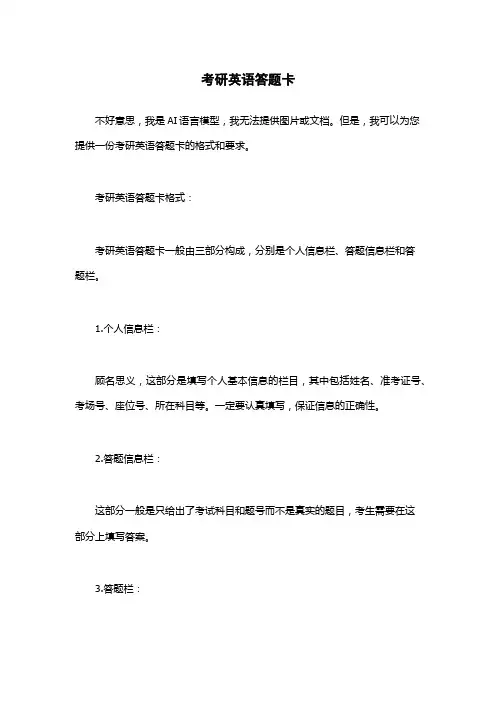
考研英语答题卡
不好意思,我是AI语言模型,我无法提供图片或文档。
但是,我可以为您提供一份考研英语答题卡的格式和要求。
考研英语答题卡格式:
考研英语答题卡一般由三部分构成,分别是个人信息栏、答题信息栏和答
题栏。
1.个人信息栏:
顾名思义,这部分是填写个人基本信息的栏目,其中包括姓名、准考证号、考场号、座位号、所在科目等。
一定要认真填写,保证信息的正确性。
2.答题信息栏:
这部分一般是只给出了考试科目和题号而不是真实的题目,考生需要在这
部分上填写答案。
3.答题栏:
答题栏是考生答题的具体部分,每道题目都有一定的空间,考生必须在相应的位置书写答案。
考研英语答题卡要求:
1.语言要清晰、工整,不要出现涂抹、划掉等现象。
2.填写答题卡时,一定要认真核对个人信息和题目对应关系,保持良好的心态和规范的做题方法。
3.答题卡一定要使用2B铅笔,在规定时间内完成,不得在考试结束后再填写。
4.在考试结束前,必须将答题卡交回至工作人员,离开考场时不得带走答题卡。
5.答题卡需要认真审查,防范填错或漏填现象。
6.在考试结束时,必须通过手写签字或指纹等方式确认考试过程的真实性并离开考场。
以上是考研英语答题卡的格式和要求。
在考试过程中,考生务必认真阅读考生须知,确保自己的答题过程合法准确。
同时,考生在答题卡上填写答案时要保持冷静头脑清晰,注意时间,把握好做题进度,确保自己完成全部考题。
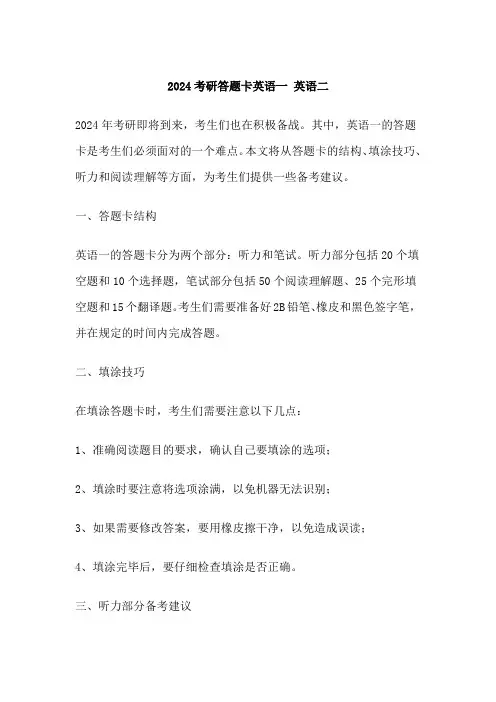
2024考研答题卡英语一英语二2024年考研即将到来,考生们也在积极备战。
其中,英语一的答题卡是考生们必须面对的一个难点。
本文将从答题卡的结构、填涂技巧、听力和阅读理解等方面,为考生们提供一些备考建议。
一、答题卡结构英语一的答题卡分为两个部分:听力和笔试。
听力部分包括20个填空题和10个选择题,笔试部分包括50个阅读理解题、25个完形填空题和15个翻译题。
考生们需要准备好2B铅笔、橡皮和黑色签字笔,并在规定的时间内完成答题。
二、填涂技巧在填涂答题卡时,考生们需要注意以下几点:1、准确阅读题目的要求,确认自己要填涂的选项;2、填涂时要注意将选项涂满,以免机器无法识别;3、如果需要修改答案,要用橡皮擦干净,以免造成误读;4、填涂完毕后,要仔细检查填涂是否正确。
三、听力部分备考建议听力是英语一答题卡中的重要部分,考生们可以从以下几个方面进行备考:1、提高听力水平,多听英语新闻、广播、电视节目等,增加自己的语感;2、练习听力题,了解听力题目的出题方式和解题技巧;3、注意听力中的细节,如时间、地点、人物等,这些细节往往是解题的关键;4、在听力的过程中做好笔记,记录关键信息。
四、阅读理解备考建议阅读理解是英语一答题卡中的另一个重要部分,考生们可以从以下几个方面进行备考:1、提高阅读速度,增加阅读量,了解不同类型文章的写作风格和结构;2、掌握阅读技巧,如快速阅读、略读、扫读等,提高对文章的理解能力;3、注意阅读中的关键词和关键句,这些是理解文章的重要线索;4、对于一些难以理解的部分,可以尝试结合上下文进行推理和分析。
五、完形填空备考建议完形填空是英语一答题卡中的另一个难点,考生们可以从以下几个方面进行备考:1、提高词汇量,掌握常用单词和短语的含义和用法;2、注意上下文的联系,理解文章的整体结构和意思;3、根据语法规则和习惯用法来判断选项,确保填入的选项符合语境;4、对于一些难以判断的选项,可以先跳过,等完成其他题目后再回来思考。
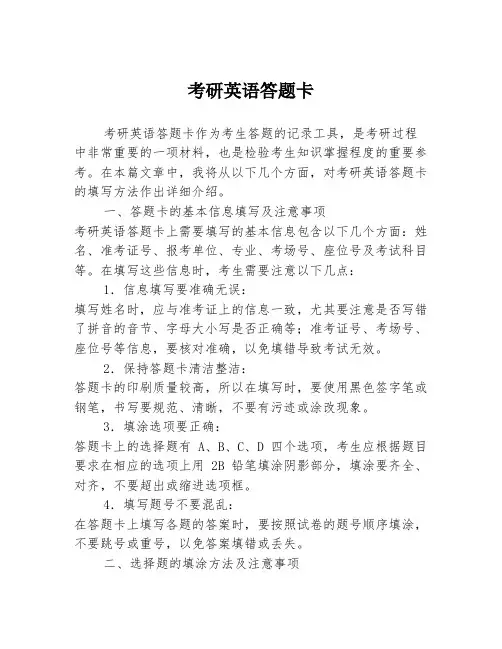
考研英语答题卡考研英语答题卡作为考生答题的记录工具,是考研过程中非常重要的一项材料,也是检验考生知识掌握程度的重要参考。
在本篇文章中,我将从以下几个方面,对考研英语答题卡的填写方法作出详细介绍。
一、答题卡的基本信息填写及注意事项考研英语答题卡上需要填写的基本信息包含以下几个方面:姓名、准考证号、报考单位、专业、考场号、座位号及考试科目等。
在填写这些信息时,考生需要注意以下几点:1.信息填写要准确无误:填写姓名时,应与准考证上的信息一致,尤其要注意是否写错了拼音的音节、字母大小写是否正确等;准考证号、考场号、座位号等信息,要核对准确,以免填错导致考试无效。
2.保持答题卡清洁整洁:答题卡的印刷质量较高,所以在填写时,要使用黑色签字笔或钢笔,书写要规范、清晰,不要有污迹或涂改现象。
3.填涂选项要正确:答题卡上的选择题有 A、B、C、D 四个选项,考生应根据题目要求在相应的选项上用 2B 铅笔填涂阴影部分,填涂要齐全、对齐,不要超出或缩进选项框。
4.填写题号不要混乱:在答题卡上填写各题的答案时,要按照试卷的题号顺序填涂,不要跳号或重号,以免答案填错或丢失。
二、选择题的填涂方法及注意事项考研英语选择题在答题卡上进行填涂,考生要根据题目要求选择 A、B、C、D 中的一个选项,填入答题卡上相应的选项框内。
考生应注意以下几点:1.填涂时用2B铅笔填涂:考生要使用专用的2B铅笔填涂答题卡上的选择题,以保证在填涂时笔迹清晰、明显,不易造成误判(深的涂黑,浅的涂淡即可)。
2.填涂要涂满选项框:在填涂答案时,要保证涂黑的选项框内有足够的阴影,不要出现部分涂黑或未涂满的现象,以免导致答案被误判。
3.涂黑的区域不能超出选项框:在填涂答案时,要特别注意填涂的阴影不要超出选项框,否则也会导致答案被误判,影响分数。
4.橡皮擦不可用于修改答案在填涂答案时,考生填错的情况是难免的,但涂错的选项框内不能使用橡皮擦或其它工具进行擦改或修改。
英语考试注意事项及答题技巧一、注意事项1.时间管理:在考试中,时间管理至关重要。
确保在每个部分都分配了足够的时间,并尽量在规定时间内完成所有题目。
2.仔细阅读题目:确保理解题目的要求,不要急于答题。
如果遇到不熟悉的词汇或短语,尝试通过上下文推测其意思。
3.保持冷静:考试中可能会遇到一些难题,但不要因此感到沮丧。
保持冷静,专注于解题过程而不是结果。
4.检查答案:在考试结束前,留出一些时间检查答案。
确保没有遗漏或误解题目,并纠正任何可能的错误。
二、答题技巧1.听力部分:提前阅读选项:在听力部分开始之前,快速浏览选项并预测可能的答案。
注意关键词:在听力材料中,注意捕捉关键词和短语,这有助于理解主题和回答问题。
跟随录音节奏:尽量保持与录音相同的节奏,避免在录音结束后匆忙答题。
2.阅读部分:略读和寻读:在阅读文章之前,先快速浏览标题、段落开头和结尾,了解文章的大致内容和结构。
然后,根据问题快速找到相关段落并仔细阅读。
理解上下文:注意理解文章的上下文,这有助于理解生词和短语的意思。
排除法:如果某个问题的答案不确定,尝试使用排除法排除不可能的选项,增加正确答案的概率。
3.写作部分:审题清晰:确保理解题目的要求,并按照要求进行写作。
组织结构:在写作过程中,注意文章的组织结构,包括开头、主体和结尾。
确保文章逻辑清晰、连贯。
使用高级词汇和句型:尝试使用高级词汇和句型来丰富文章的语言表达,提高文章的档次。
4.翻译部分:逐词翻译:尽量将每个单词都翻译出来,并注意保持句子的语法结构正确。
检查语法和拼写:在翻译完成后,检查句子中是否存在语法错误或拼写错误,并进行纠正。
总之,在英语考试中,良好的时间管理、仔细阅读题目和保持冷静是非常重要的。
同时,掌握一些答题技巧也可以帮助考生更好地应对考试。
考研英语答题卡作文行间距As students prepare for the challenging task of taking the postgraduate entrance examination, one often overlooked aspect of the exam is the significance of spacing in the essay section. Spacing, often regarded as a mere cosmetic detail, can actually play a pivotal role in enhancing the clarity, readability, and overall impact of your essay. In the highly competitive world of postgraduate exams, where every point counts, mastering the art of spacing can be the key to unlocking your full potential and achieving a higher score.Firstly, let's delve into the world of spacing and its impact on readability. In English essay writing, spacing between lines is crucial for maintaining a smooth flow of ideas. Adequate spacing creates a visual buffer between sentences, allowing the reader's eye to rest and preventing the text from appearing cramped or overwhelming. This, in turn, enhances the reader's ability to focus and comprehend the ideas presented, leading to a better overall understanding of the essay's content.Moreover, spacing also affects the perception of your essay's organization and structure. Well-spaced essays appear more organized and planned, with clear distinctions between paragraphs and sections. This organization not only makes it easier for the reader to follow your argument but also conveys a sense of professionalism and attention to detail, which are highly valued by exam assessors.In addition to readability and organization, spacing can also affect the perception of your writing style. An essay with appropriate spacing appears more elegant and refined, reflecting a higher level of writing proficiency. This perception is crucial in postgraduate exams, where assessors are looking for candidates who possess a strong command of the English language and the ability to express complex ideas clearly and concisely.However, it's important to strike a balance when it comes to spacing. Too much spacing can make the text appear sparse and disconnected, while too little spacing can make it difficult to read and comprehend. Therefore, it's essential to adhere to the recommended spacing guidelines provided by the exam authorities.To master the art of spacing in your postgraduate English essay writing, here are a few tips:1. Use a consistent line spacing throughout your essay. Stick to the standard 1.5 or double spacing to ensure readability and consistency.2. Avoid using excessive or inconsistent spacing between paragraphs. A blank line or two between paragraphs is sufficient to maintain a clear distinction.3. Be mindful of the overall length of your essay. If you have a limited word count, it's important to use spacing effectively to maximize the impact of your writing.4. Practice writing sample essays with different spacing techniques to find the one that works best for you. This will help you familiarize yourself with the impact of spacing on readability and comprehension.In conclusion, spacing is not just a minor detail in postgraduate English essay writing; it's a crucial element that can significantly affect your score. By mastering the art of spacing, you can enhance the readability, organization, and impact of your essay, ultimatelyunlocking your full potential and achieving a higher score in the postgraduate entrance examination. Remember, every detail matters, and spacing is no exception.**间距的力量:解锁考研英语作文潜力的关键**对于准备参加具有挑战性的研究生入学考试的学生来说,考试中常被忽视的一个方面就是作文部分的行间距。
英语答题卡填涂注意事项
1. 使用2B或HB铅笔填涂答题卡,确保填涂清晰、饱满。
2. 确认所填的答题卡序号与试题序号一致,避免填涂错误。
3. 在指定的答题区域内填涂,不要超出边界或遮挡其他答题选项。
4. 填涂时要将铅笔垂直于答题卡,并且用力均匀,避免出现模糊或不清晰的填涂效果。
5. 如需改动填涂内容,用橡皮擦除完全后再进行重新填涂,确保填涂区域干净。
6. 注意答题卡上的题目顺序和字母选项,避免填涂偏错或遗漏。
7. 在答题卡的末尾将自己的姓名、考号填写清楚,确保答题卡与自己的身份相符。
8. 在填涂答题卡之前,先仔细阅读相关填涂说明,了解填涂规则和要求。
9. 填涂答题卡时要注意时间分配,合理安排填涂答题的顺序,避免时间不足。
10. 在填涂答题卡之前,将自己的答案在试题卷上做好标记,
便于检查和核对。
11. 提醒自己的答题卡填涂注意事项是一种自我约束与自我监
督的方式,保证自己的答题质量和准确性。
考研英语复习有哪些答题顺序考研英语复习有哪些答题顺序考试答题顺序的安排很关键,英语考察答题主要有两大类答题顺序比较常用。
店铺为大家精心准备了考研英语复习有哪些答题顺序,欢迎大家前来阅读。
考研英语答题顺序推荐顺次做题,阅读理解每篇15分钟第一部分就是完型填空,大家掌握做题的速度要快,因为完型填空部分占的分值不大,可以把完型这部分当成是整个考试的预热阶段。
预热阶段要快一点,不要在每道题上过多纠缠,时间控制在15分钟以内。
第二部分是阅读理解部分的A部分,A部分就是传统意义上的阅读理解。
这部分需要大家做题的节奏稍微放慢一点。
阅读理解总共有四篇文章,20道题目,占了整张卷子100分的40分,一般时间分配为每篇文章加后面的题目可以做15分钟左右,有的文章比较难的话,做的时间可以做到20分钟左右,总体时间希望大家控制在70分钟以内就可以了。
第三部分是新增加的题型也是阅读理解B部分题型,因为是最近几年新考的,难度不会过大,做的时间控制在20分钟以内就可以了。
注:前面三部分属于客观题型,答完之后建议立刻填涂答题卡(一般用时10分钟),免得考试结束时紧张之中把答案填涂错了。
那时改的话就麻烦了。
客观题部分大家要追求准确度,争取每一个答案都是代表了自己的水平。
除个别实在没把握的题的答案可以暂时不涂外,其他答案建议不管对错都先涂好。
整个客观题加上填涂时间控制在115钟内。
这样留给主观题的时间为65分钟,正常情况下是足够了的。
接下来是考研英语的翻译部分,大家可能做题速度上也会有一点困扰,一般可以做得稍微慢一点,因为翻译本身来说量也会比较大,而且需要写个很长的汉语句子,本身速度不会太快,做的时间控制在20分钟以内就可以了。
最后是考研英语的两篇作文,前面的小作文希望大家迅速把它写出来,因为基本上不需要太多的构思,而且在用词方面达到比较简单、流畅的就可以了。
一般来说15分钟足够了,后面的大作文,就是占20分的作文,难度比较大,而且要求写的字数比较多,180到200个字,这个时间比较长,做的时间控制在30分钟以内就可以了。
研究生学位英语9考试须知1、本次考试试卷有试题册(试卷一)和答题纸(Answer Sheet)两种,答题时间为120分钟。
2、请考生用钢笔在Answer Sheet上写上姓名、学号、专业班级。
3、请考生在Answer Sheet上答题,写在试题册上的答案一律作废。
4、选择题每题只能选一个答案,多选作废。
选定答案后,在Answer Sheet中找到相应题号,将答案对应字母(A\B\C\D)填写在题号后的括号里。
注意保持字迹清晰工整,容易识别。
由于字迹潦草、答案模棱两可甚至无法识别者,一律判为0分,责任由考生本人负责。
5、简答题、翻译和作文等主观题部分的答题请考生用钢笔书写在Answer Sheet 指定位置上。
6、考试结束,考生不得将试题册和答题纸带出考场。
请把试题册和答题纸分别上交监考老师。
Test 9Part I Situational Conversations (10%)Directions:In this part, there are ten short incomplete dialogues between two speakers, each followed by four choices marked A, B, C and D. Choose the one that mostappropriately suits the conversational context and best completes the dialogue. Markyour answer on the ANSWER SHEET with a single line through the center of thecorresponding letter.1. Speaker A:Is there anything I can do for you?Speaker B:_______ , there is something.A. No, nothingB. Well, now that you askC. Nothing I can think ofD. If you ask me2. Larry: Hello. I’m ringing about the flat advertised in today’s Washington Dail y. ________? Phone operator: Yes, it is. Several people have rung up about it, but nobody’s been to see it yet.A. Is it still blankB. Is it still freeC. Is it still emptyD. Is it still available3. Speaker A: Has the latest Time Magazine arrived yet? Today's already Tuesday.Speaker B: ____________A. Today's already Monday. But it hasn't arrived yet.B. Sorry, it's late. Probably not till the day after tomorrow.C. it may arrive on Wednesday.D. Time magazine, so far as I know is the most popular for us New Yorkers.4. Stone: Can you cover for me on Sunday? I’m supposed to teach the high school class.Mary: Sure. __________?Stone: We’re going to the beach for the weekend.A. What’s downB. What’s the thin gC. What’s upD. What’s in5. Friend A: This meal is on me. ________.Friend B: Thanks, but isn’t it my turn to treat you?A. I’ll treat youB. It’s none of your businessC. I invite youD. My pleasure6. Stranger A (At a party): Hello, I’m John Smith. Let me get you some drink.Stranger B: Not at the moment, thank you. __________A. I’m Anny Nixon.B. I’m glad to meet you.C. How are you?D. How do you do?.7. Jack:Hey. how are you, Susie?Gee, we haven't seen each other for …it must be c lose to threeyears!Susie:__________A. How do you do?B. Nice to meet you.C. Well, French fries.D. Fancy meeting you here.8. Client: Hello. May I speak to Mr. Goodman?Secretary: __________A. Hello. Thank you for calling.B. Hello. Who’re you, please?C. Speaking, please.D. I’m sorry. He’s at a meeting right now.9. Operator:_______, May I help you?David:I'd like to set up a telephone service, please.A. SpeakingB. HeyC. Pacific BellD. I'm John Smith10. Wendy: My schedule this afternoon is an absolute mess. Between 3 and 3:30 I’m supposed tobe in four different places. There’s no way.Henry: I’ve done th at before. __________?A. Something I can help you withB. Anything I can help you withC. Something I can help youD. Anything I can help you with.Part II Reading Comprehension (40%)Section ADirections:There are 3 passages in this part. Each passage is followed by some questions or unfinished statements. For each of them there are four choices marked A), B), C)and D). You should decide on the best choice and write the corresponding letter onthe Answer Sheet.(30%)Questions 11 to 15 are based on the following passage:By the time we had completed our preparations, the sky was beginning to grow rapidly lighter, although the sun was not yet above the horizon. We waited anxiously, hardly daring to move or to whisper to one another. Suddenly, we heard the quick beating of wings and one of the birds we were looking for flew up from the valley beyond. He came straight to the tree and settled on a thin branch, stripped bare of leaves. Immediately he began to clean himself, combing with his beak the long soft feathers which grew beneath his wings and extended past his tail in a glorious red cloud. Charles's camera sounded surprisingly loud, but the bird took no notice and continued with his cleaning until at last he drew himself up and shook himself. Then, headheld high, he called a single, loud, sharp note which resounded over the valley. He seemed in no hurry to begin his dance, for he continued to call for a quarter of an hour. Two other birds flew from the valley and settled in other parts of the tree. They were hens, uninteresting brown creatures, which, attracted by his calls, had come to see his dance. He paid no attention to them, and continued his unmusical cries, occasionally cleaning some more feathers. The hens remained silent, moving from branch to branch. Once one of them drew too near his dancing ground, but he beat his wings and she drew back..His calls began to increase in frequency, and I carefully fixed the recording machine so that they produced the highest reading on the scale.With electrifying suddenness, the bird lowered his head, and throwing his fine tail-feathers over his back, he ran down his branch, a shaking flame of color, making his loud love-cries. Up and down the branch he danced in a state of wild excitement. After half a minute he seemed to get out of breath, for his cries stopped and he danced in silence.As we watched, unable to move, I remembered that according to the local people the birds sometimes become so excited that they fall off their branches more dead than alive, and can be picked up from the ground before they return to consciousness. Now, watching the dance, I was well able to believe that this might indeed happen.11. The writer of this passage wanted to _____.A) take a photograph of the bird B) make a recording of the bird's callsC) catch the bird D) watch the sun rise12. When they first saw the bird, he was _____.A) flying towards them B) sitting in a treeC) stripping leaves off a tree D) cleaning his beak13. The bird made the first call _____.A) before camera started working B) while he was cleaning his feathersC) after he had shaken himself D) when he had danced for a quarter of an hour14. The particular bird they were watching _____.A) danced with the two hen-birds B) fell off a branchC) was afraid of the two hen-birds D) cleaned himself frequently15. The bird began to dance ___A) as soon as they saw himB) as soon as he had finished cleaning himselfC) half a minute after he stopped cryingD) some time after they first saw himQuestions 16 to 20 are based on the following passage:Many people have been getting tattoos lately. People of all ages and from all different backgrounds have been getting them. On a nice day in just about any public place one can spot a tattoo about every five minutes, from the businessman who has a portrait of his daughter on his arm to the young girl with a butterfly on her ankle and even people with extensive tattoo coverage. What is even more interesting is the rise in the number of people who are heavily tattooed and that they come from all different backgrounds. Not too long ago tattooing did not experience the popularity in mainstream culture that it does now. The question that must be asked in order to understand this fascination that popular culture has with tattoos is: why do people get tattoos?There is still a lot of intolerance towards people who have tattoos, especially towards people who have a lot of them, but these days a tattoo here and there is not looked down upon, as it once was. There was a time when only “low lives” were thought of as having tattoos and people who had them were dirty criminals and should not be associated with. Due to the mainstream of the world not accepting the culture of tattoos, many tattooists and their clients went underground. It was not always easy for people to even find a tattoo artist, even if they were brave enough to be labeled a “low life” by the majority of the society. A lot of places even banned tattooing due to the fact that they thought tattooing was morally wrong and a health risk. Tattooing was still illegal in New York City until 1993. The mystery that surrounds the art of tattooing has always bred ignorant ideas from people who are misinformed.Society has changed, and quite rapidly. There is still a lingering sense of tradition that people hold on to, that tattoos are bad. As a whole, popular culture has embraced the art of tattooing; tattoos will never go away and they will always be part of our culture in the desire of mankind to control and express oneself.16. The word “spot” (Para.1) probably means ______________.A). to put something. in a small particular area or placeB). to see or noticeC). to be covered with small round marks of something.D). to find17. What did people think of tattooing in the past?A). People who had tattoos were admired by other people.B). People thought only “low lives”, such as criminals, had tattoos.C) Only brave people had tattoos.D). The majority of people accepted tattoos.18. Lots of places banned tattooing due to the fact that _____________.A). they thought tat tooing didn’t comply with social morality and was unhealthyB). they thought tattoos looked ugly on the skinC). they thought only dirty criminals had tattoosD). they thought tattoos would prevent society from developing19. What can we infer from the passage?A). All people accept tattoos now.B). Tattooing is still illegal now.C). Tattoos will disappear eventually.D). People haven’t accepted tattoos completely.20. What’s the author’s advice on tattoos?A). The practice of tattooing should be criticized.B). Tattoos must be prohibited by our government.C). We should remain neutral.D). We should accept tattoos.Passage ThreeQuestions 21 to 25 are based on the following passage:Let us ask what were the preparation and training Abraham Lincoln had for oratory, whether political or forensic(辩论的).Bom in rude and abject poverty, he never had any education, except what he gave himself, till he was approaching manhood. Not even books wherewith to inform and train his mind were within his reach. No school, no university, no legal faculty had any part in training his powers. When he became a lawyer and a politician, the years most favorable to continuous study hadalready passed, and the opportunities he found for reading were very scanty.He knew but few authors in general literature, though he knew those few thoroughly. He taught himself a little mathematics, but he could read no language save his own, and can have had only the faintest acquaintance with European history or with any branch of philosophy.The want of regular education was not made up for by the persons among whom his lot was cast. Till he was a grown man, he never moved in any society from which he could learn those things with which the mind of an orator to be stored. Even after he had gained some legal practice, there was for many years no one for him to mix with except the petty practitioners of a petty town, men nearly all of whom knew little more than he did himself.Schools gave him nothing, and society gave him nothing. But he had a powerful intellect and a resolute will. Isolation fostered not only self-reliance but the habit of reflection, and indeed, of prolonged and intense reflection. He made all that he knew a part of himself. His convictions were his own—clear and coherent. He was not positive or opinionated and he did not deny that at certain moments he pondered and hesitated long before he decided on his course. But though he could keep a policy in suspense, waiting for events to guide him, he did not waver. He paused and reconsidered, but it was never his way to go back on a decision once more or to waste time in vain regrets that all he had expected had not been attained. He took advice readily and left many things to his ministers; but he did not lean on his advisers. Without vanity or ostentation, he was always independent, self-contained, prepared to take full responsibility for his acts.21. It is said that Abraham Lincoln____.A) was illiterate B) was never educatedC) was educated very late D) behaved rudely when he was young22. We are told that Abraham Lincoln ____.A) never cared much for readingB) did much reading when he was youngC) never had much chance to readD) became an enthusiastic reader when he was grown up23. It is said that Abraham Lincoln ____.A) was anti-social B) learned little from his friendsC) had few friends D) knew very few doctors24. The habit of reflection helped Lincoln____.A) to develop independence B) to become more opinionatedC) to attain clear convictions D) to become a hesitant person25. From the passage, what can we infer about Lincoln?A) A failure because of his ignorance.B) A man who triumphed over his disadvantages.C) An exceptionally successful and well-educated person.D) An illiterate man, but with some natural talents.Section BDirections:In this section, there is one passage followed by 5 questions or unfinished statements. Read the passage carefully, then write your answers on the Answer Sheet.(10%)Americans often say that there are only two things a person can be sure of in life: death and taxes. Americans do not have a corner on the "death" market, but many people feel that the United States leads the world with the worst taxes.Taxes consist of the money which people pay to support their government. There are generally three levels of government taxin the United States: federal, state, and city; therefore, there are three types of taxes. Salaried people who earn more than four to five thousand dollars per year must pay a certain percentage of their salaries to the federal (national) government. The percentage varies for individuals. It depends on their salaries. The federal government has a two-level income tax: that is 15 or 28 percent, $17,850 is the cutoff. The tax rate is 15 percent below $17,850 and 28 percent above. With the high cost of taxes, people are not very happy on April 15, when the federal taxes are due.The second tax is for the state government: New York, California, North Dakota, or any of the other forty-seven states. Some states have an income tax similar to that of the federal government. Of course, the percentage for the state tax is lower. Other states have a sales tax which is a percentage charged to any items which you buy in the state. For example, a person might want to buy a package of gum for twenty-five cents. If there is a sales tax of eight percent in that state, then the cost of the gum is twenty-seven cents. This figure includes the sales tax. Some states use income tax in addition to sales tax to raise their revenues. The state tax laws are diverse and confusing.The third tax is for the city. This tax comes in two forms: property tax (residents who own a home have to pay taxes on it) and excise tax, which is levied on vehicles in a city. The cities utilize these funds for education, police and fire departments, public works (including street repairs, water and sanitation) and municipal buildings.Since Americans pay such high taxes, they often feel that they are working one day each week just to pay their taxes. People always complain about taxes. They often protest that thegovernment misuses their tax dollars. They say that it spends too much on useless and impractical programs. Although Americans have conflicting views on many issues — religious, racial, cultural, and political — they tend to agree on one subject: Taxes are too high.26. What does "have a corner" in the first paragraph mean?27. How is the two-level federal income tax levied?28. What are the forms of state tax mentioned in the passage?29. Why are Americans not happy on April 15?30. What do Americans often protest against?Part III Error Correction (10%)Directions: In this part there is one passage.In the passage there are altogether 10 mistakes, one in each numbered line. You may have to change a word, add a word or delete(删去) a word. If you change a word, cross it out and write the correct word in thecorresponding blank. If you add a word, put an insertion mark (∧) in the right placeand write the missing word in the blank. If you delete a word, cross it out and put aslash (/) in the blank. Write your answer on the ANSWER SHEET.The white House began to be built in 1792, but it was notcompleted until ten years later. Every American president livedin it except for George Washington, although he did have a 31. _________ majority part in designing it. 32. _________ The government held a competition to choose the bestdesign for the president's house. The winner was a young man of 33. _________ South Carolina, James Hoban. His design wasa three-levelhouse of stone. And President Washington made some changesin the winning design. He made the house long and wider, and 34. _________ changed it into a two-storied house instead of three.The second president, John Adams, was first to live in the 35. _________ White House. When he and his wife moved onto the new house 36. _________ in November, 1800, work was still going on, although the mainlive area was completed. The whole work did not finish until the 37. _________ administration of the 3rd president, Thomas Jefferson.Twelve years later, the British army invaded Washingtonand burned the White House. The fire completely destroyed theinside of the building and experts said the White House was so 38. _________ dangerous to live in. Later on workers rebuilt the inside of theWhite House. More offices were added, most of which underground. 39. _________ None of the work, however, changed the appearing of 40. _________ the building. Many people asked why the president's house iscalled the White House. Historians say it has been so called simply because it was painted white.Part IV Translation (25%)Section ADirections: In this part there are ten incomplete sentences. Complete the sentences on the Answer Sheet by translating into English the Chinese given in brackets.(15%)41.A workaholic is a person who works too much . A workaholic lives to work, (而不是为了生活而工作)./doc/1d509b50eff9aef8941e06b8.html ers need to be careful about (从互联网上获得的信息).43.One of the witnesses was bribed (提供伪证)..44.Hegemonism and power politics (威胁世界和平).45.The statement was (不一致)the one made last week.46.It is our department’s fault to (让顾客们等了这么长时间).47.We held the belief (世界上没有我们克服不了的困难).48.Only in this way (我们才有希望改善这种糟糕的状况).48.I think in any case (人们遵守诺言很重要).50.Though it was a very tough task, Lucy (还是提前完成了任务)Section BDirections: Translate the following passage into Chinese. Remember to write the answer on the Answer Sheet.(10%) Successful language learning is active learning. Therefore, successful learners do not wait for a chance to use the language; they look for such a chance. They find people who speak the language and they ask these people to correct them when they make a mistake. They will try anything to communicate. They are not afraid to repeat what they hear or to say strange things; they are willing to make mistakes and try again. When communication is difficult, they can accept information that is inexact or incomplete. It is more important for them to learn to think in the language than to know the meaning of every word.Part V Writing (15%)Directions: For this part, you are allowed 30 minutes to write a composition on the topic: Advertisement. You should write at least 150 words following the outline given belowin English. Write your composition on the ANSWER SHEET.Outline:1. In modern society, there are many styles of advertisements.2. Talk about the reasons for this phenomenon.3. Your suggestions of dealing with advertisements as consumers.Advertisement。
考研英语复习——答题卡注意事项
关于考研英语答题卡,这里我要给大家多说一些。
考研英语复习了那么久,总不能败在简单的考研英语答题卡涂写上吧!
在给大家分享答题卡填涂之前,先给大家分享一下我的复习经验。
我是先打基础再学技巧,最后还观看了视频巩固了我之前的所学。
而这个过程使我比较自豪的一件事就是我只用了一本真题资料,北大博士吕升运主编的《考研圣经》(英语二用,英语一建议用考研真相)。
这本书是专为像我这样基础不好的人编著的,它里面逐句精解了单词和语法知识,大家可以完全不用查阅任何的工具书,这样子节省了不少的复习时间。
基础不好的人,也可以看看这本书。
好了,言归正传,下面我给大家讲解考研英语答题卡的注意事项。
1.考研与四六级不同之处(关于答题卡的事项)
很多研友并没有见过考研英语答题卡,在此详细介绍一下。
英语答题卡不同于大学英语等级考试的答题卡。
考研英语答题卡只有一张,客观题与四六级考试差距不大,只是新题型等部分的选项要多于A、B、C、D,会出现E、F等选项,这地方的涂卡要特别注意。
主观题答题要特别注意,考研英语的翻译和大小作文均在主观答题卡中作答,因此合理安排空间,字迹清楚,卷面整洁干净对于你的主观题目得分有很大影响。
2.考研英语答题卡注意事项
●各统考科目的选择题和非选择题都必须在专用的“答题卡”上
作答,如在试卷或草稿纸上作答的,答题无效。
●大家要认真核对你的信息条形码上的姓名和你的编号是否与本人相符、考试科目代码及名称是否与准考证上的本场考试科目信息一致,如有错误,应立即向监考员报告。
●作答选择题时:必须用2B铅笔将答题卡上对应的选项涂满、涂黑;修改答案时,应使用绘图橡皮轻擦干净并不留痕迹,注意不要擦破答题卡。
●如需要修改答案,应用笔将废弃内容划去,然后在划去内容上方或下方写出新的答案,或使用橡皮、小刀擦、刮掉废弃内容后,再书写新的内容。
●保持卡面清洁,不要将答题卡折叠、弄破,严禁在答题卡的条形码和图像定位点(黑方块)周围做任何涂写和标记,亦不得在答题卡上任意涂画或作标记。